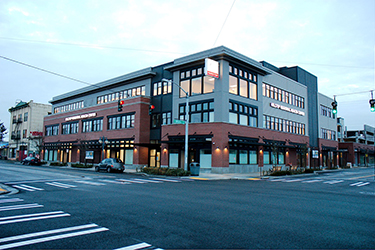|
Subscribe / Renew |
|
|
Contact Us |
|
| ► Subscribe to our Free Weekly Newsletter | |
| home | Welcome, sign in or click here to subscribe. | login |
Environment
| |
 |
September 24, 2015
Survey: O’Brien & Co.
Specialty: Green building consulting; policy and program support; education and training
Management: Alistair Jackson, principal and owner; Donna Trost, operations director and owner; Elizabeth Powers, principal and owner
Founded: 1991
Headquarters: Seattle
2014 revenues: $1.3 million
Projected 2015 revenues: $1.3 million
Projects: University of Washington North Campus housing, Seattle; Sullivan’s Gulch multifamily, Portland; Enterprise 2015 Criteria single/multifamily specifications, Columbia, Maryland
Andrea Lewis, associate principal for O’Brien & Co., answered questions about the firm’s activities, what happens when the building boom slows down, and what’s around the corner for the sustainability movement.
Q: Which services are most in demand and where do you see growth in five years?
A: We’re seeing a lot more interest in how we can provide services that bridge the gap between design and construction to ongoing operations, helping to maintain the performance of the project and the ongoing sustainability benefits for the long haul.
For us, that takes many shapes. In some cases it has been leading exciting research on new and innovative technologies that help create better visibility about how a building is operating — and where there are opportunities for improvement. In others, it has been helping property managers and owners find ways to engage building occupants to understand their role in helping cut water, energy and waste.
If and when the building boom slows down in our region, this interest in the different ways to approach sustainable occupancy and operations in all buildings will take the forefront.
Q: What’s a really interesting project you’re working on?
A: We are just getting started on the rollout of our “building efficiency coaching services” to 12 different affordable housing buildings owned by two different affordable housing developers. We’ve been delivering coaching for individual buildings for some time, but we really see this as a portfolio-scale service and solution.
We’re engaged with a technology partner, BrightPower, to help expedite and visualize all of the data we’ll be collecting, and are partnering with Emerald Cities Collaborative under their RENEW program to provide building performance assessments that inform program scope for upgrades and maintenance schedules, as well as managing the construction phase for these upgrades.
Q: Has the direction of the business changed since founder Kathleen O’Brien sold her stake in 2011?
A: We are at our core still seeking to create a more sustainable built environment through our services, which almost always reflect Kathleen’s foundational approach of building industry capacity to do so. We also still have Kathleen’s same yearning to be the wedge that helps drive change where it’s most needed, though the kind of change needed now looks very different from what it did when she first started the business.
Now, we’re seeing the scale of our services expand “out” in the realm of large-scale, high-performance infrastructure that has grown over the past few years, and we have one of the first Envision Certified Professionals and Trainers on staff. (Envision is a sustainability rating system for infrastructure.)
At the same time, we’re seeing it move “in” to really focus on the role of the people inside buildings, and how buildings really impact those people — we also have one of the first WELL Accredited Professionals on staff. (The WELL Building Standard is a framework backed by health and design experts to understand, measure and improve human health and well-being as outcomes from building design and operation.)
Q: What are a couple of the biggest challenges you’re facing?
A: We used to say that getting buy-in on good process, like integrated process, was an upfront challenge we often faced on our projects. But increasingly, in part thanks to great IP standards, and inclusion of IP in various rating systems and even adopted at policy level here in our county, this is less the case.
The challenge we continue to face is helping our clients understand the array of technology solutions available to them and assessing which ones are best suited for their needs, as well as understanding the role of tenant behavior and operating practices on building performance.
Q: What’s the next frontier for sustainability?
A: There are a lot of old frontiers that the industry is still working on to really figure out!
Energy has certainly gotten the most play, but water, waste and well-being are others that easily come to mind, and it’s hard to note these without also noting the direct tie-in to climate, and the urgency for real solutions that we can scale without losing adaptability.
So this next frontier might really be about effectively scaling the broad range of solutions out there for greater adoption without bypassing the much-needed place-based thinking that has to happen for a solution to be effective.
We’re working with some pretty progressive clients who are taking more of a strategic approach to their thinking and planning for larger scale development, but we’d love to see this become the norm across the board.
Other Stories:
- LID development training is a game changer here
- Survey: Shannon & Wilson
- Survey: Ridolfi
- Survey: Climate Solutions
- Survey: Cascadia Consulting Group
- Survey: Golder Associates
- How deep green buildings can educate kids
- Here’s how to improve environmental health and safety
- New Ecology cleanup guidance: mirage or oasis?
- Kirkland taps county’s purple pipes for recycled water
- Drought heats up battle over water rights
- Designing infrastructure to combat climate change
- Building green? Don’t forget green financing
- Survey: Innovex Environmental Management



